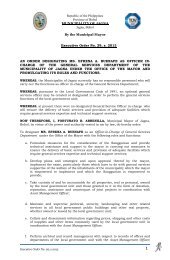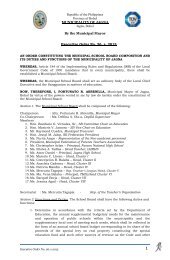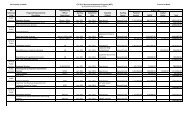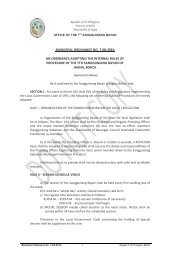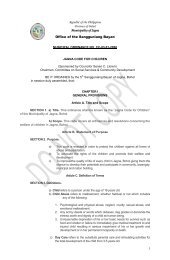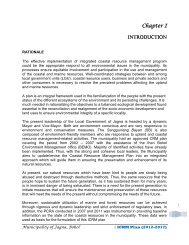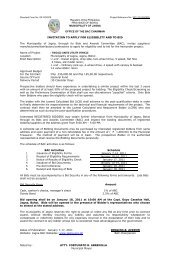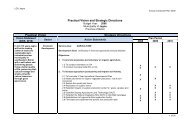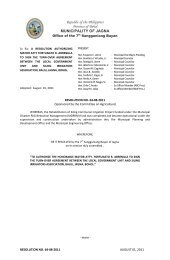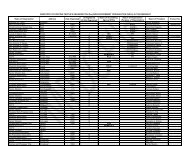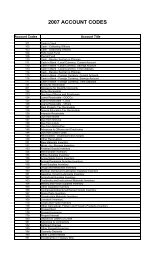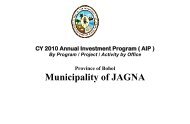DRRM Orientation to Punong Barangays of Jagna
DRRM Orientation to Punong Barangays of Jagna
DRRM Orientation to Punong Barangays of Jagna
You also want an ePaper? Increase the reach of your titles
YUMPU automatically turns print PDFs into web optimized ePapers that Google loves.
<strong>Orientation</strong> and Planning Workshop on Disaster Risk<br />
Reduction and Manage <strong>to</strong> <strong>Punong</strong> <strong>Barangays</strong> <strong>of</strong> <strong>Jagna</strong><br />
Capt. Goyo Hall, Municipal<br />
Building, <strong>Jagna</strong> Bohol<br />
Oc<strong>to</strong>ber 10-11, 2011
Day 1, Oc<strong>to</strong>ber 10, 2011<br />
Registration<br />
The first day <strong>of</strong> the orientation and planning workshop began with a registration <strong>of</strong><br />
participants. The <strong>of</strong>ficials coming from the thirty-one (31) barangay <strong>of</strong> <strong>Jagna</strong> queued at the<br />
registration table <strong>of</strong> Goyo Hall <strong>to</strong> sign in their names in the attendance sheets.<br />
Opening Program<br />
At 8:40 in the morning, the activity was formally started with an invocation and tri-color<br />
hymns which were played through multimedia presentations. Meanwhile, Engr. Gerry V. Araneta,<br />
Municipal Disaster Risk Reduction Management Officer (M<strong>DRRM</strong>O) <strong>to</strong>ok the floor in initiating <strong>to</strong><br />
settle down the participants by expressing his cordial greetings for taking high regard on the<br />
invitation. He was especially thanking the Bohol Integrated Development Foundation, Inc. (BIDEF)<br />
for ably facilitating the activity despite that their municipality has been undertaking conscientiously<br />
on disaster risk reduction matters.<br />
He stressed further that the activity was a collaborative effort between and among the special<br />
bodies <strong>of</strong> <strong>Jagna</strong> Municipal Disaster Risk Reduction Management Council and BIDEF thru the GIFT<br />
project. That one <strong>of</strong> the project’s lined up activities has <strong>to</strong> do with the disaster risk reduction<br />
management despite that their municipality and its component barangays have already come across<br />
this type <strong>of</strong> activity. However, he rationalized that in undergoing the same it would further enhance<br />
their knowledge and enable them <strong>to</strong> know the salient features <strong>of</strong> the latest law which is the R.A.<br />
10121.<br />
Conversely, he explained that said activity was intended only for the coastal barangays<br />
following wholly on the targets <strong>of</strong> the GIFT project but he requested Francis <strong>to</strong> include the upland<br />
barangays <strong>to</strong> maximize the activity because disaster risk reduction management is not only a<br />
confronting development concern <strong>of</strong> the coastal barangays but an encompassing matter in the whole<br />
area <strong>of</strong> <strong>Jagna</strong>. Thus, the <strong>Jagna</strong> M<strong>DRRM</strong>C deliberately collaborated with BIDEF and counter-parted<br />
for this orientation and planning workshop.<br />
Rationale<br />
Engr. Araneta gave the rationale <strong>of</strong> the activity. He put emphasis by stating that it is a<br />
declared policy <strong>of</strong> the state <strong>to</strong> uphold people constitutional rights <strong>to</strong> life and property by addressing<br />
the root causes <strong>of</strong> vulnerabilities <strong>to</strong> disaster risk reduction and management by building the capacity<br />
<strong>of</strong> local communities including climate change impacts. It was also reinforced in the local<br />
government code as mandate <strong>of</strong> each LGU which states that “it is the duty <strong>of</strong> the municipal<br />
government <strong>to</strong> adopt measures <strong>to</strong> protect the inhabitants <strong>of</strong> the municipality from the harmful effects<br />
<strong>of</strong> manmade or natural disasters and calamities and <strong>to</strong> provide relief services and assistance for<br />
victims during and in the aftermath <strong>of</strong> the said disasters and calamities.”<br />
In effect, he described how the present governance <strong>of</strong> each LGU is taking a strong advocacy<br />
on the disaster risk reduction activities. He was thankful that <strong>Jagna</strong> is actively doing their share on<br />
2 | P a g e <strong>Orientation</strong> & Planning on <strong>DRRM</strong> – Oc<strong>to</strong>ber 10-11, 2011 | Capt. Goyo Hall, Municipal Building, <strong>Jagna</strong>, Bohol
this matter. He made the barangay captains present in the activity aware <strong>of</strong> their responsibilities <strong>to</strong><br />
their constituents especially in times <strong>of</strong> disasters and calamities and the importance <strong>of</strong> doing<br />
preparedness activities that they should take it on with utmost coordination <strong>to</strong> M<strong>DRRM</strong>C.<br />
Later in the discussions he notified the participants that the resource person will be tackling<br />
the R.A.10121 for them <strong>to</strong> recall the relevant provisions and that they should not hesitate <strong>to</strong> ask<br />
questions and clarifications.<br />
Expectation and Objective Settings<br />
Afterwards, Francis facilitated the setting <strong>of</strong> expectations <strong>of</strong> the 2-day orientation and drew<br />
from the participants the following:<br />
To know more about the <strong>DRRM</strong>.<br />
What <strong>to</strong> do in times <strong>of</strong> disasters and calamities?<br />
Where <strong>to</strong> find budget and the ways <strong>to</strong> expend the 5% <strong>DRRM</strong> fund.<br />
While everyone concurred with the above expectations, the objective and contents <strong>of</strong> the activity<br />
was followed as shown in the table below:<br />
General Objective Contents Purpose<br />
To equip with basic information<br />
on DRR and the salient<br />
provision <strong>of</strong> R.A. 10121 that<br />
can be useful in the<br />
development <strong>of</strong> barangay<br />
disaster risk reduction and <strong>to</strong><br />
mainstream the DRR in the<br />
LGUs program.<br />
Concepts, approaches,<br />
principles and processes <strong>of</strong><br />
DRR.<br />
Know what are disasters,<br />
how, why and it occur. We<br />
will understand also the<br />
different hazards.<br />
Reducing the risk and<br />
formulation <strong>of</strong> <strong>DRRM</strong> plan<br />
based on the NEDA and<br />
DILG prescribed process<br />
on local <strong>DRRM</strong> planning<br />
and budgeting.<br />
To level-<strong>of</strong>f and establish<br />
common understanding<br />
on DRR.<br />
To understand its<br />
(hazards) relationship <strong>to</strong><br />
climate change.<br />
To know the processes on<br />
how <strong>to</strong> expend the 5%<br />
fund for <strong>DRRM</strong>.<br />
While waiting for Hon. Fortuna<strong>to</strong> R. Abrenilla, <strong>to</strong> arrive for his Message, Francis thoroughly<br />
went over the flow <strong>of</strong> activities in the program. He laid emphasis by saying that they allotted time for<br />
open forum after each <strong>to</strong>pic is discussed <strong>to</strong> facilitate for the questions and clarifications <strong>of</strong> the<br />
participants. Likewise he said that, the orientation is just a prepara<strong>to</strong>ry activity for the actual<br />
planning process which would be scheduled in the months <strong>to</strong> come.<br />
3 | P a g e <strong>Orientation</strong> & Planning on <strong>DRRM</strong> – Oc<strong>to</strong>ber 10-11, 2011 | Capt. Goyo Hall, Municipal Building, <strong>Jagna</strong>, Bohol
Message<br />
Atty. Fortuna<strong>to</strong> R. Abrenilla<br />
Municipal Mayor<br />
<strong>Jagna</strong>, Bohol<br />
Good morning everyone!<br />
We are here again for another reflective intention which is the orientation and planning workshop for<br />
disaster risk reduction management.<br />
First and foremost, I would like <strong>to</strong> congratulate our MPDC, Engr. Gerry Araneta for collaborating<br />
with this activity. In relation <strong>to</strong> this, I received a letter from the DENR for geological assessment <strong>to</strong><br />
be conducted here in <strong>Jagna</strong> on Oc<strong>to</strong>ber 13 <strong>to</strong> November 13, 2011. We know for a fact that our<br />
municipality is very vulnerable <strong>to</strong> various hazards. Relatively, we just recently saw and heard the<br />
disaster that hit in Luzon areas. It is very frightening <strong>to</strong> note that for the first time in his<strong>to</strong>ry the<br />
Luneta park was flooded. I had been in Manila for 35 years and I have never witnessed nor<br />
experienced flooding in Luneta park before.<br />
Consciously, I think we should take this as gradual effects <strong>of</strong> climate change that disaster truly<br />
strikes everywhere as we might have also experienced here in <strong>Jagna</strong>.<br />
As our response <strong>to</strong> this overwhelming adversity, it is good <strong>to</strong> note that our government mandated us<br />
<strong>to</strong> allot budget or fund for the DRR that we need <strong>to</strong> properly plan for it because we don’t want <strong>to</strong><br />
happen just like what Japan had experienced. That despite their well-preparedness and their<br />
consciousness that they are tsunami and earthquake prone area however, disaster struck them simply<br />
because, it let <strong>of</strong>f no one.<br />
In closing, I am hoping that this activity would help us in knowing effective ways <strong>to</strong> mitigate<br />
disasters and <strong>to</strong> know how we could fully utilize the 5% fund for DRR activities.<br />
Again, thank you and good morning.<br />
4 | P a g e <strong>Orientation</strong> & Planning on <strong>DRRM</strong> – Oc<strong>to</strong>ber 10-11, 2011 | Capt. Goyo Hall, Municipal Building, <strong>Jagna</strong>, Bohol
CONCEPTS, APPROACHES, PRINCIPLES and PROCESSES <strong>of</strong> DRR/Understanding Hazards<br />
The Aksyon Klima Pilipinas and Disaster Risk Reduction Network Philippines are<br />
consortium <strong>of</strong> the civil society organizations in the Philippines who were responsible in the crafting<br />
<strong>of</strong> the R.A. 10121 Climate Change Act. In fact, this group actively participated in the crafting <strong>of</strong><br />
P<strong>DRRM</strong> Act <strong>of</strong> the Philippines later part <strong>of</strong> 2007 by collaborating issues on disasters in the<br />
Philippines because its group member organizations were coming from the different parts <strong>of</strong> the<br />
country.<br />
Why do we need <strong>to</strong> have a new law? For 20 years <strong>of</strong> existence <strong>of</strong> the PD1566, seemingly this<br />
decree has not conceptually made <strong>to</strong> address in reducing the risks <strong>of</strong> disasters. If we are <strong>to</strong> look at it<br />
in the holistic point <strong>of</strong> view, the PD 1566 principle is centered on response only. Later the<br />
discussions will tackle on how this existing law shifted <strong>to</strong> a new paradigm and how the civil society<br />
organizations have helped in crafting it.<br />
The Office <strong>of</strong> Civil Defense-National Disaster Risk Reduction and Management Council<br />
accepted the fact that this is the most consulted law in the Philippines. But the disheartening fact and<br />
possibly its downside was, if not <strong>of</strong> “Ondoy’s” catastrophe way back in September 2009 it would<br />
not have been enacted in<strong>to</strong> law. But as the former president’s graceful exit the law was enacted as<br />
her enormous response <strong>to</strong> the tragedy, hence, its approval on 5 May 2010.<br />
Multi-media Presentation <strong>of</strong> the Ginsaugon Landslide Tragedy in February 2006<br />
The mayor mentioned in his message about some unforgettable disasters that happened now<br />
and before. So, the speaker has searched in the internet what catastrophe so devastating ever<br />
recorded in the disaster his<strong>to</strong>ry <strong>of</strong> the Philippines that the participants could still vividly recall, relate<br />
and which happened nearest <strong>to</strong> Bohol. Hence, he shared presentation <strong>of</strong> some <strong>of</strong> the pho<strong>to</strong>s captured<br />
in the Ginsaugon, St. Bernard, Southern Leyte Landslide Tragedy.<br />
Some <strong>of</strong> the highlighted points in the presentation are the following:<br />
The extent <strong>of</strong> landslide spanned for 300 hectares.<br />
The volume <strong>of</strong> land that fell down, collapsed and eroded was 20-30 million metric<br />
<strong>to</strong>ns.<br />
More or less 3,000 lives were killed during the landslide and 10 had survived.<br />
All experts on disaster rescue from all over the world went <strong>to</strong> help in responding the<br />
landslide tragedy.<br />
It showed us that a mere response operation was futile when disaster had already<br />
taken place. And the needs <strong>to</strong> greatly consider regarding vulnerabilities are crucial<br />
fac<strong>to</strong>rs.<br />
Way back 1995-1996 the risks had already been identified and the Mines and Geoscience<br />
Bureau <strong>of</strong> the DENR even categorically declared that Ginsaugon is not a<br />
livable place due <strong>to</strong> presence <strong>of</strong> a fault line.<br />
The catastrophe happened in Ginsaugon was due <strong>to</strong> these two reasons; geological<br />
5 | P a g e <strong>Orientation</strong> & Planning on <strong>DRRM</strong> – Oc<strong>to</strong>ber 10-11, 2011 | Capt. Goyo Hall, Municipal Building, <strong>Jagna</strong>, Bohol
(presence <strong>of</strong> fault line) and meteorological (it rained beyond normal causing the soil<br />
<strong>to</strong> wear <strong>of</strong>f) hazards.<br />
In the bigger perspective <strong>of</strong> said catastrophe, it was a combination <strong>of</strong> three events (1)<br />
rock slide, (2) mud flow and (3) debris avalanche. Said events seldom happened but it<br />
occurred simultaneously that day in Ginsaugon.<br />
The message that it brought <strong>to</strong> us is that the disasters nowadays have escalated with a<br />
combination <strong>of</strong> a changing climate and the existing hazards.<br />
If we look at these hazards, each and every one <strong>of</strong> us has capacity <strong>to</strong> determine it as<br />
part in our preparedness response – no landslides so devastating only if we’re aware<br />
and prepared <strong>of</strong> it.<br />
In the DRR principle, the only thing that exists is natural hazards, when there is<br />
typhoon and earthquake it is because it is part <strong>of</strong> the natural system <strong>of</strong> the earth.<br />
Any response team who would be responding in any disaster when it already caused<br />
damaged and has lost many lives. When this team only do retrieval operation it would<br />
not appropriate and worthy for them <strong>to</strong> be called disaster response team but otherwise.<br />
The communities are the best responders when sufficiently capacitated. So that in<br />
times <strong>of</strong> crisis, they would not anymore be a liability but an asset.<br />
The latest law on <strong>DRRM</strong> intends <strong>to</strong> shift the concept <strong>of</strong> victims and responders<br />
relationship. Because in our culture, when we are vulnerable <strong>to</strong> hazards we begin <strong>to</strong><br />
consider ourselves as victims already even when there is no disaster has yet occurred.<br />
TOPIC 1: Basic Concept <strong>of</strong> Disaster Risk Management<br />
Nexus <strong>of</strong> Climate Change Adaptation<br />
and Disaster Risk Reduction<br />
For. An<strong>to</strong>nio D. Balang, Jr.<br />
Nexus means convergence <strong>of</strong> CCA and DRR<br />
An exercise <strong>to</strong> connect the 9 dots with 4 lines without lifting a pen was given. Since nobody<br />
got the exercise correctly the speaker presented his answer and emphasized that for the dots<br />
<strong>to</strong> be connected with lines one should extend out from the arrangement <strong>of</strong> the dots. The<br />
message <strong>of</strong> the exercise provided that one should “think outside the box”. Relatively, the<br />
DRR and CCA are not technical issues if everyone does their share in little ways they can.<br />
The effects <strong>of</strong> typhoons Reming, Ondoy, Falcon and Pedring are glaring signs <strong>of</strong> the presence<br />
climate change.<br />
The world’s temperature nowadays is progressively rising due <strong>to</strong> global warming.<br />
When earth’s temperature goes high it will naturally do a so-called “healing process” such as<br />
creating a heavy rainfall causing some parts <strong>of</strong> the globe <strong>to</strong> be heavily flooded.<br />
The effects <strong>of</strong> climate change are gradual processes <strong>of</strong> bringing the people in<strong>to</strong> dire<br />
circumstances like absence <strong>of</strong> potable water, threats <strong>to</strong> security (housing and livelihood), food<br />
supply crisis, alteration <strong>of</strong> diseases and deteriorating health conditions, worsening<br />
development and future uncertainties which would result in due course <strong>to</strong> massive fatality or<br />
loss <strong>of</strong> lives.<br />
6 | P a g e <strong>Orientation</strong> & Planning on <strong>DRRM</strong> – Oc<strong>to</strong>ber 10-11, 2011 | Capt. Goyo Hall, Municipal Building, <strong>Jagna</strong>, Bohol
For every increase <strong>of</strong> temperature <strong>to</strong> 1 degree Centigrade, 10% <strong>of</strong> the agricultural production<br />
decreases. When our population increases yearly at the rate <strong>of</strong> 4.2% and given the decrease <strong>of</strong><br />
10% <strong>to</strong> agricultural production apparently, a new kind <strong>of</strong> disaster has come in<strong>to</strong> being.<br />
Majority <strong>of</strong> the population depend their livelihood so much on the products <strong>of</strong> the<br />
environment.<br />
The climate change did already happen, now, worldwide and right at our very front yard. It is<br />
now becoming the most dominant issue <strong>of</strong> our time.<br />
Climate change is a significant and lasting change in the statistical distribution <strong>of</strong> weather<br />
patterns over periods ranging from decades <strong>to</strong> millions <strong>of</strong> years. It may be a change in<br />
average weather conditions or the distribution <strong>of</strong> events around that average.<br />
Disaster is a serious disruption <strong>of</strong> the functioning community or a society causing<br />
widespread human materials, economic (assets, goods and services) or environmental losses<br />
which exceed the ability <strong>of</strong> the affected community/society <strong>to</strong> cope using its own resources<br />
The two types <strong>of</strong> Climate Change: Natural and Anthropogenic. The natural (ice age)<br />
processes <strong>of</strong> climate change evolved in million years while the anthropogenic (human-made)<br />
climate change only occurred thousands <strong>of</strong> years – the increase <strong>of</strong> emission <strong>of</strong> fluorocarbons<br />
is one <strong>of</strong> the causes <strong>of</strong> this type <strong>of</strong> climate change.<br />
What the world is now faced with is the combination <strong>of</strong> these two types <strong>of</strong> climate change.<br />
To fully understand the natural climate change a simulation on how the Philippine<br />
archipelago had evolved 50 million years ago was shown. Making Palawan as the oldest and<br />
the biggest land mass has ever existed before the other land masses <strong>of</strong> the Philippine<br />
archipelago came about. That for every million years <strong>of</strong> evolution a land mass occurred and<br />
production <strong>of</strong> carbon dioxide is inevitable due <strong>to</strong> presence <strong>of</strong> living things inhabiting in the<br />
land masses.<br />
The fluctuating presentation <strong>of</strong> temperature shows the variances <strong>of</strong> the condition <strong>of</strong> the<br />
climate in the world. As for instance, during spring season in temperate countries the flora<br />
breathe in the natural carbon dioxide and during the summer and fall seasons the ocean takes<br />
in the natural carbon dioxide.<br />
The Philippine Hazards (IPCC AR4) on an average, 20 cyclones cross the Philippines Area <strong>of</strong><br />
Responsibility with about 8 <strong>to</strong> 9 landfall each year; with an increase <strong>of</strong> 4.2 in the frequency <strong>of</strong><br />
cyclones entering PAR during the period 1990 <strong>to</strong> 2003<br />
Increase in mean annual, maximum and minimum temperatures by 0.14°C between 1971 <strong>to</strong><br />
2000<br />
Increase in annual mean rainfall since 1980s and in number <strong>of</strong> rainy days since 1990s,<br />
increase in inter-annual variability <strong>of</strong> onset <strong>of</strong> rainfall<br />
In SEA: Increase in hot days and warm nights and decrease in cold days and nights between<br />
1961 and 1998<br />
In November 2008 the Manila Observa<strong>to</strong>ry and DENR presented the following projected risk<br />
simulation: (a) <strong>to</strong>p 20 provinces at risk <strong>to</strong> draught, (b) <strong>to</strong>p 20 provinces at risk <strong>to</strong> increase <strong>of</strong><br />
temperature, (c) <strong>to</strong>p 20 provinces risk <strong>to</strong> typhoons, (d) <strong>to</strong>p 20 provinces at risk <strong>to</strong> projected<br />
rainfall. When these projections were presented in one <strong>of</strong> the gatherings some became<br />
dubious about it and no one <strong>to</strong>ok it seriously not until when the great disaster happened when<br />
“Ondoy” hit Metro Manila.<br />
The China and USA are two powerful countries in the world with great contributions <strong>to</strong> CO 2<br />
7 | P a g e <strong>Orientation</strong> & Planning on <strong>DRRM</strong> – Oc<strong>to</strong>ber 10-11, 2011 | Capt. Goyo Hall, Municipal Building, <strong>Jagna</strong>, Bohol
emission along with other countries in Europe, Japan and Australia. The actions taken <strong>of</strong> the<br />
leaders <strong>of</strong> these nations <strong>to</strong>wards climate change would have a substantial effects on the third<br />
world countries like Philippines that terribly affected by the global warming.<br />
CO 2 emissions <strong>of</strong> developed countries have continued <strong>to</strong> rise and the Kyo<strong>to</strong> Pro<strong>to</strong>col targets<br />
are in jeopardy.<br />
The Copenhagen Climate Change Summit in 2009 was supposedly the deadline set by all<br />
parties <strong>to</strong> legally bind and agree with <strong>to</strong> ensure that CO 2 emission will not exceed <strong>to</strong> 2˚C<br />
however, the G-8 countries (powerful and industrialized countries) sidestepped with another<br />
accord (Copenhagen Accord) which gradually exterminated the Kyo<strong>to</strong> Pro<strong>to</strong>col. The Cop 15<br />
was considered by other countries - FAILURE. It failed <strong>to</strong> find political will <strong>to</strong> meet the<br />
challenges <strong>of</strong> climate change. It was the year where most <strong>of</strong> us failed <strong>to</strong> find the courage <strong>to</strong><br />
do so.<br />
The challenge is, when these powerful nations do not have the will <strong>to</strong> take appropriate and<br />
empathetic actions, the third world countries which were adversely affected should now start<br />
doing pro-active actions locally.<br />
Millions will be at risks in 2080 if the temperature will continue <strong>to</strong> rise beyond 2˚C. Risks <strong>of</strong><br />
coastal flooding, malaria, hunger and water shortage will significantly increase also [Parry<br />
et. al. (2001) “Millions at Risks” Glob.Env.Change.]<br />
The following inevitable climate impacts which would greatly affect the developing countries<br />
are: environmental destruction, economic disruption, social dislocation and political<br />
destabilization.<br />
Climate change does not need technical solutions but a fundamental 180˚ shift <strong>of</strong> principles<br />
and change <strong>of</strong> lifestyle.<br />
Climate change will exacerbate the impact <strong>of</strong> existing non-climate stressors and institutional<br />
challenges on all sec<strong>to</strong>rs.<br />
DRR is a systematic effort <strong>to</strong> analyze and manage the causes <strong>of</strong> disasters by reducing<br />
vulnerabilities and enhancing capacities in order <strong>to</strong> lessen the adverse impacts <strong>of</strong> hazards<br />
and the probability <strong>of</strong> disaster.<br />
CCA is an adjustment in natural or human systems in response <strong>to</strong> actual or expected climate<br />
stimuli or their effects, which moderates harm or exploits beneficial opportunities (IPCC).<br />
The similarities are in objectives and purpose is the same which is <strong>to</strong> increase the<br />
adaptability <strong>of</strong> climate exacerbating impacts; end goal, <strong>to</strong> develop resiliency <strong>of</strong> the<br />
communities <strong>to</strong> combat the impacts <strong>of</strong> hazards and change the lifestyle; benefits <strong>to</strong> society<br />
would be safer lives; methods, just the same; seeking <strong>to</strong> address root causes and increasing<br />
influence.<br />
But it differs in origin and his<strong>to</strong>ry, time scale, scope, perspective and others but in the<br />
question whether <strong>to</strong> take on DRR or CCA, the answer is, it does not MATTER – for as long<br />
as our actions are geared <strong>to</strong>wards saving the lives <strong>of</strong> the people.<br />
Which brings back <strong>to</strong> the definition <strong>of</strong> RISK = Hazard Exposure x Vulnerability/Capacity<br />
Climate Change Climate Hazards (unpredictable, non-linear, variable, uncertain,<br />
extreme, unprecedented, perplexing, ever-changing, unexpected)<br />
DRR and CCA mean addressing the root causes <strong>of</strong> people’s vulnerability.<br />
Risk reduction is a development issue. Until there is a pressing issue affecting an individual<br />
just the same a disaster is not yet addressed.<br />
8 | P a g e <strong>Orientation</strong> & Planning on <strong>DRRM</strong> – Oc<strong>to</strong>ber 10-11, 2011 | Capt. Goyo Hall, Municipal Building, <strong>Jagna</strong>, Bohol
Question/Clarification<br />
Are climate change impacts selectively affect communities? Climate change impacts affect all<br />
individuals and geographic locations. Say for instance, the risk projection in 2008 presented awhile<br />
ago the Province <strong>of</strong> Bohol is not at risk <strong>of</strong> heavy rainfall and typhoon which may affect severe<br />
flooding <strong>to</strong> some municipalities but in 2010 we were affected with El Nino causing problems in the<br />
decrease <strong>of</strong> agricultural production and increasing <strong>of</strong> dengue cases.<br />
TOPIC 2: Salient Features <strong>of</strong> Hyogo Framework and R.A. 10121 (Philippine Disaster Risk<br />
Reduction and Management Act <strong>of</strong> 2010)<br />
What is <strong>DRRM</strong> Act?<br />
For. An<strong>to</strong>nio D. Balang, Jr.<br />
The long title <strong>of</strong> the law states “An Act Strengthening the Philippine Disaster Risk<br />
Reduction and Management System, Providing for the National Disaster Risk<br />
Reduction and Management Framework and Institutionalizing the National Disaster<br />
Risk Reduction and Management Plan, Appropriating Funds Therefore and for Other<br />
Purposes”<br />
The said law described the need for establishing a disaster risk reduction management<br />
system.<br />
Disaster cannot be managed but the risk that causes it can be managed.<br />
The other concept <strong>of</strong> the said law is the creation <strong>of</strong> a management framework.<br />
Two Hazard Terms<br />
Disaster Response. The provision <strong>of</strong> emergency services and public assistance during or<br />
immediately after a disaster in order <strong>to</strong> save lives, reduce health impacts, ensure public<br />
safety and meet the basic subsistence needs <strong>of</strong> the people affected. Disaster response is<br />
predominantly focused on immediate and short-term needs and is sometimes called<br />
“disaster relief”.<br />
Disaster Risk Reduction. A systematic effort <strong>to</strong> analyze and manage the causes <strong>of</strong> disasters<br />
by reducing vulnerabilities and enhancing capacities in order <strong>to</strong> lessen the adverse impacts<br />
<strong>of</strong> hazards and the probability <strong>of</strong> disaster<br />
Disaster risk reduction is looking at how exposed the vulnerable communities are <strong>to</strong> hazards.<br />
Understanding the Terms and Its Underlying Fac<strong>to</strong>rs<br />
Hazards Exposure Vulnerability/Capacity<br />
The degree <strong>to</strong> which<br />
people and properties are<br />
likely <strong>to</strong> experience<br />
hazards<br />
A phenomena, event,<br />
occurrence or human activity<br />
that may cause injury, loss <strong>of</strong><br />
lives and damage <strong>to</strong> property<br />
and the environment.<br />
Typhoons Dense population VULNERABILITY<br />
The characteristics <strong>of</strong> a<br />
community that make it<br />
susceptible <strong>to</strong> a hazard or<br />
capable <strong>of</strong> coping and<br />
recovering from the<br />
damaging effects <strong>of</strong> a<br />
disaster.<br />
9 | P a g e <strong>Orientation</strong> & Planning on <strong>DRRM</strong> – Oc<strong>to</strong>ber 10-11, 2011 | Capt. Goyo Hall, Municipal Building, <strong>Jagna</strong>, Bohol
Floods<br />
Drought<br />
Earthquake<br />
Tsunami<br />
Fire<br />
Wars<br />
Epidemics<br />
Terrorism<br />
Prepare for Hazards<br />
(1) Know the hazards<br />
(2) Contingency Planning<br />
Moni<strong>to</strong>r Hazards<br />
(1) Early warning systems<br />
Mitigate Hazards<br />
(1) Protect communities<br />
through infrastructure<br />
Living in high-risk areas<br />
Minimize<br />
Exposure<br />
(1) Relocate<br />
(2) Evacuate<br />
Transfer Risks<br />
(1) Insurance and<br />
Social protection<br />
(Encourage volunteerism)<br />
Poverty<br />
Disabilities<br />
Poor health and<br />
sanitation<br />
Hunger<br />
Poor land use planning<br />
Overexploited and<br />
degraded natural<br />
resources<br />
Poor infrastructures<br />
Poor governance<br />
CAPACITY<br />
Wise use <strong>of</strong> resources<br />
Robust infrastructure<br />
Strong and good<br />
governance<br />
Reduce<br />
Vulnerabilities<br />
Enhance<br />
Capacities<br />
(1) Organized communities<br />
(2) Strong governance<br />
(3) Food security<br />
(4) Quality education<br />
(5) Health and sanitation<br />
(6) Access <strong>to</strong> safe water<br />
(7) Reduced poverty<br />
(8) Diversified livelihoods<br />
(9) Management <strong>of</strong> natural<br />
resources<br />
(9) Protection <strong>of</strong> the environment<br />
(10) Access <strong>to</strong> lifeline elements<br />
(11) Retr<strong>of</strong>itting<br />
(12) Infrastructure development<br />
Why do we need <strong>to</strong> have a new law?<br />
10 | P a g e <strong>Orientation</strong> & Planning on <strong>DRRM</strong> – Oc<strong>to</strong>ber 10-11, 2011 | Capt. Goyo Hall, Municipal Building, <strong>Jagna</strong>, Bohol
Bot<strong>to</strong>ms-up and participa<strong>to</strong>ry approach – the LGUs should be in the forefront and<br />
given the primary role in DRR not the military nor the AFP<br />
What is the basis <strong>of</strong> the <strong>DRRM</strong> Act?<br />
The <strong>DRRM</strong> Act adopts and adheres <strong>to</strong> principles & strategies consistent with the<br />
international standards set by the Hyogo Framework for Action (HFA). The HFA is a<br />
comprehensive, action-oriented response <strong>to</strong> international concern about the growing impacts<br />
<strong>of</strong> disasters on individuals, communities & national development.<br />
The HFA was developed following the tsunami in 2004 (Sumatra) which claimed more than<br />
200,000 lives and massively damaged properties and the environment. This emphasized the<br />
need for a paradigm shift from disaster response <strong>to</strong> disaster risk reduction (DRR).<br />
Governance - the DILG is strictly giving directive <strong>to</strong> incorporate <strong>DRRM</strong> Plan in the<br />
budget preparation<br />
Risk Assessment – Assessing the possible risks<br />
Knowledge Management – the principle behind this priority action is about building<br />
safety and resiliency among communities in the vulnerable situations.<br />
Vulnerability Reduction – should have considerations in identifying those who are<br />
vulnerable sec<strong>to</strong>rs<br />
Disaster Preparedness – it came as the last component because if we are established and<br />
the 1 st four components are effectively functioning, disaster preparedness response would<br />
be an isolated case already.<br />
What are the salient features <strong>of</strong> the <strong>DRRM</strong> Act?<br />
Adherence <strong>to</strong> universal norms, principles, and standards <strong>of</strong> humanitarian assistance<br />
Good governance through transparency and accountability<br />
Strengthened institutional mechanism for <strong>DRRM</strong><br />
Integrated, coordinated, multi-sec<strong>to</strong>ral, inter-agency, and community-based approach <strong>to</strong><br />
disaster risk reduction<br />
Empowerment <strong>of</strong> local government units (LGUs) and civil society organizations (CSOs) as<br />
key partners in disaster risk reduction<br />
Integration <strong>of</strong> the <strong>DRRM</strong> in<strong>to</strong> the educational system<br />
Establishment <strong>of</strong> the <strong>DRRM</strong> Fund (<strong>DRRM</strong>F) at the national and local levels<br />
Providing for provisions on the declaration <strong>of</strong> a state <strong>of</strong> calamity, remedial measures,<br />
prohibited acts and penalties<br />
11 | P a g e <strong>Orientation</strong> & Planning on <strong>DRRM</strong> – Oc<strong>to</strong>ber 10-11, 2011 | Capt. Goyo Hall, Municipal Building, <strong>Jagna</strong>, Bohol
How has the <strong>DRRM</strong> structure changed?<br />
In PD 1566 the structure is composed <strong>of</strong> councils. Technically speaking, in organizational<br />
management, a council’s role is primarily a policy making body. The previous structure<br />
created an Office <strong>of</strong> Civil Defense (OCD) as an implementing arm. However, in reality,<br />
this implementing arm has not reached out through the barangay levels because the OCD<br />
acts similarly as other national government line agencies in nature.<br />
In the <strong>DRRM</strong> Act it was restructured by creating an overseeing and implementing bodies<br />
with <strong>DRRM</strong>Os and Committees <strong>to</strong> compose the implementing arm.<br />
The <strong>DRRM</strong> Committee in the barangay should not necessarily be chaired by the <strong>Punong</strong><br />
Barangay.<br />
In Section 11 <strong>of</strong> this Act states that, The Barangay Disaster Coordinating Councils shall<br />
cease <strong>to</strong> exist and its powers and functions shall henceforth be assumed by the<br />
existing Barangay Development Councils (BDCs) which shall serve as the<br />
L<strong>DRRM</strong>Cs in every barangay.<br />
Because technically speaking, the BDC is the one responsible <strong>to</strong> plan on what <strong>to</strong> do with<br />
the 20% development fund in the barangay.<br />
Use <strong>of</strong> L<strong>DRRM</strong>F<br />
Section 21. the present Local Calamity Fund shall henceforth be known as the Local<br />
Disaster Risk Reduction and Management Fund (L<strong>DRRM</strong>F).<br />
Not less than five percent (5%) <strong>of</strong> the estimated revenue from regular sources shall<br />
be set aside as the L<strong>DRRM</strong>F <strong>to</strong> support disaster risk management activities such<br />
as, but not limited <strong>to</strong>, pre-disaster preparedness programs including training,<br />
purchasing life-saving rescue equipment, supplies and medicines, for post-disaster<br />
activities, and for the payment <strong>of</strong> premiums on calamity insurance.<br />
Salaries and wages shall not be included in the 70% <strong>of</strong> the 5%.<br />
The 5% L<strong>DRRM</strong>F can now be made as continuing appropriation when said fund is<br />
unexpended.<br />
The community risk assessment should be the basis for <strong>DRRM</strong> planning.<br />
Unexpended L<strong>DRRM</strong>F goes <strong>to</strong> a trust fund which will be used solely for <strong>DRRM</strong><br />
activities <strong>of</strong> the L<strong>DRRM</strong>C within the next five (5) years. Funds which are still not fully<br />
utilized after five (5) years shall go back <strong>to</strong> the general fund and will be available for<br />
other social services <strong>to</strong> be identified by the local sanggunian. (Sec. 21 par. 3)<br />
12 | P a g e <strong>Orientation</strong> & Planning on <strong>DRRM</strong> – Oc<strong>to</strong>ber 10-11, 2011 | Capt. Goyo Hall, Municipal Building, <strong>Jagna</strong>, Bohol
The L<strong>DRRM</strong>C may transfer the <strong>DRRM</strong> Fund <strong>to</strong> support disaster risk reduction work <strong>of</strong><br />
other L<strong>DRRM</strong>Cs which are declared under a state <strong>of</strong> calamity (Sec. 21 par.1)<br />
The L<strong>DRRM</strong> Plan shall be the basis for the use and disbursement <strong>of</strong> the Local <strong>DRRM</strong><br />
Fund. This shall be moni<strong>to</strong>red and evaluated by the L<strong>DRRM</strong>C (Sec. 21).<br />
Who can declare a state <strong>of</strong> calamity?<br />
The President can declare a state <strong>of</strong> calamity upon the recommendation <strong>of</strong> the N<strong>DRRM</strong>C.<br />
The local sanggunian may now also declare and lift the state <strong>of</strong> calamity within their<br />
locality. This is upon the recommendation <strong>of</strong> the L<strong>DRRM</strong>C based on the results <strong>of</strong> the<br />
damage assessment and needs analysis (Sec. 16).<br />
The P<strong>DRRM</strong>C can declare that a province is under a state <strong>of</strong> calamity if 2 contiguous or<br />
more municipalities are affected. But in the Barangay level, they may declare and lift the<br />
state <strong>of</strong> calamity upon the approval <strong>of</strong> the B<strong>DRRM</strong>C.<br />
Prohibitions and Penalities<br />
Dereliction <strong>of</strong> duties which leads <strong>to</strong> destruction, loss <strong>of</strong> lives, critical damage <strong>of</strong> facilities<br />
and misuse <strong>of</strong> funds.<br />
Preventing the entry and distribution <strong>of</strong> relief goods in disaster-stricken areas, including<br />
appropriate technology, <strong>to</strong>ols, equipment, accessories, disaster teams/experts<br />
Buying, for consumption or resale, from disaster relief agencies any relief goods,<br />
equipment or other aid commodities which are intended for distribution <strong>to</strong> disaster<br />
affected communities<br />
Buying, for consumption or resale, from the disaster affected recipient any relief goods,<br />
equipment or other aid commodities received by them<br />
Selling <strong>of</strong> relief goods, equipment or other aid commodities which are intended for<br />
distribution <strong>to</strong> disaster victim<br />
Forcibly seizing relief goods, equipment or other aid commodities intended for or<br />
consigned <strong>to</strong> a specific group <strong>of</strong> victims or relief agency.<br />
Section 20 <strong>of</strong> the <strong>DRRM</strong> Act imposes the penalty <strong>of</strong><br />
Fine between P50,000 <strong>to</strong> P500,000<br />
Imprisonment between six months <strong>to</strong> one year<br />
Both fine and imprisonment<br />
Confiscation or forfeiture <strong>of</strong> the objects and instrumentalities used<br />
For government <strong>of</strong>ficials, he/she shall be perpetually disqualified from public <strong>of</strong>fice in<br />
addition <strong>to</strong> the fine, imprisonment and confiscation.<br />
TOPIC 3: Understanding Hazards<br />
Understanding Hazards<br />
For. An<strong>to</strong>nio D. Balang, Jr.<br />
Understanding Typhoon<br />
A s<strong>to</strong>rm is an inclement weather condition with wind speed or gustiness <strong>of</strong> 35<br />
kilometers per hour.<br />
13 | P a g e <strong>Orientation</strong> & Planning on <strong>DRRM</strong> – Oc<strong>to</strong>ber 10-11, 2011 | Capt. Goyo Hall, Municipal Building, <strong>Jagna</strong>, Bohol
An average <strong>of</strong> 20 typhoons will come in the Philippine Area <strong>of</strong> Responsibility (PAR)<br />
yearly.<br />
If this weather condition will cross the PAR, it will then be called a s<strong>to</strong>rm in the<br />
predetermined local name.<br />
A s<strong>to</strong>rm crosses from West Philippine Sea and the Pacific Ocean.<br />
The three kinds <strong>of</strong> s<strong>to</strong>rm are: (1) tropical depression – with gustiness <strong>of</strong> 35 <strong>to</strong> 63<br />
kilometers per hour; (2) tropical s<strong>to</strong>rm – with gustiness <strong>of</strong> 64 <strong>to</strong> 117 kilometers per<br />
hour and; (3) typhoon – with gustiness <strong>of</strong> 118 kilometers per hour above and a super<br />
typhoon with a wind pacing 250 kilometers per hour and above.<br />
A s<strong>to</strong>rm has an eye with a diameter measuring 10-20 kilometers. When confined in<br />
the eye <strong>of</strong> the s<strong>to</strong>rm, the weather condition is calm, less cloudy atmosphere and<br />
almost there is an absence <strong>of</strong> rainfall. Damage can be experienced whenever an eye<br />
wall hits.<br />
The Philippine Atmospheric, Geophysical and Astronomical Services Administration<br />
(PAGASA) is the only <strong>of</strong>ficial government agency allowed <strong>to</strong> provide relevant<br />
information regarding weather conditions in the country.<br />
S<strong>to</strong>rm advisory can also be acquired through DOST-PAGASA SMS with SMART<br />
service mobile phone by typing in the message box BAGYO INFO ADVISORY and<br />
send <strong>to</strong> 7002586 with a 2 pesos charge.<br />
The weather system provides information every 4 hours (5 a.m/5p.m. and 11<br />
a.m./11p.m.)<br />
The risks may brought about by typhoon are: (1) landslide, (2) heavy rainfall and<br />
flood, (3) s<strong>to</strong>rm surge, (4) strong wind.<br />
Public S<strong>to</strong>rm Warning Signal<br />
S<strong>to</strong>rm Signal Gustiness <strong>of</strong> Wind (kph) Onset Velocity (hr.)<br />
1 30-60 36<br />
2 61-100 24<br />
3 101-185 18<br />
4 Above 185 12<br />
The higher the s<strong>to</strong>rm signal and its corresponding gustiness the faster it reaches or hit<br />
the areas which are declared <strong>to</strong> be within the particular s<strong>to</strong>rm signal.<br />
Things <strong>to</strong> do before the typhoon hit on: (1) prepare flashlights, batteries and matches<br />
for possibility <strong>of</strong> blackout, (2) save and s<strong>to</strong>re up enough food supplies and potable<br />
water, (3) inform other family members on the preparations, (4) make necessary<br />
repair <strong>to</strong> stabilize the condition <strong>of</strong> the house , (5) plan for the likelihood <strong>of</strong> evacuation,<br />
(6) frequently moni<strong>to</strong>r the radio and t.v. announcement regarding the s<strong>to</strong>rm warning<br />
and (7) prepare emergency kit and ensure that it’s dry all the time.<br />
Understanding Flash flood<br />
Two types <strong>of</strong> flash flood: (1) slow onset and (2) rapid onset.<br />
Understanding S<strong>to</strong>rm surge<br />
Rapid upsurge <strong>of</strong> salt/sea water due <strong>to</strong> water tide and strong wind caused by typhoon.<br />
The Philippines is susceptible <strong>to</strong> s<strong>to</strong>rm surges because it has a long stretch <strong>of</strong><br />
shoreline.<br />
In the land use planning, the areas which are risky <strong>to</strong> s<strong>to</strong>rm surges should be given<br />
considerations.<br />
14 | P a g e <strong>Orientation</strong> & Planning on <strong>DRRM</strong> – Oc<strong>to</strong>ber 10-11, 2011 | Capt. Goyo Hall, Municipal Building, <strong>Jagna</strong>, Bohol
Understanding Tsunami & Tidal Wave<br />
Tsunami and tidal wave are two different things.<br />
From time <strong>to</strong> time there are areas in the Philippines that experience 2 tidal waves<br />
yearly.<br />
Tidal wave is derived from the words “astronomical tide” or the results <strong>of</strong> “high” and<br />
“low” tide activity – the gravitational pull <strong>of</strong> the moon and sun <strong>to</strong> the bodies <strong>of</strong> water<br />
specifically the oceans.<br />
During June and November the highest tide in the Philippines is beyond normal level.<br />
In the course <strong>of</strong> this event, presence <strong>of</strong> momentary sea current is very high and when<br />
strong wind turn up it will create tidal waves.<br />
Tsunami occurred due <strong>to</strong> “seismic activity” and if there are raptures <strong>of</strong> “fault lines”.<br />
Types <strong>of</strong> faulting : normal, reverse and slide slip faulting<br />
Types <strong>of</strong> tsunami: local and foreign<br />
Tsunami is not categorically an effect <strong>of</strong> climate change.<br />
All hazards have ecological benefits or importance. They are natural cleansers.<br />
Understanding Lightning<br />
Three forms <strong>of</strong> lightning: (1) Forked - crooked lightning bolts discharge from cloud<br />
<strong>to</strong> ground or cloud <strong>to</strong> air, (2) Sheet/Flash Lightning - clouds, rain blocks forked<br />
lightning bolt, but flash illuminates clouds, (3) Ball – on rare occasions, small<br />
growing balls loops from the cloud but quickly vanish.<br />
To avoid dangers in lightning: don’t stay out <strong>of</strong> the building, avoid staying near the<br />
objects which have electricity, don’t use electrical gadgets and appliances, don’t use<br />
telephones or mobile phones, remain inside the vehicle, don’t hold objects which are<br />
prone <strong>to</strong> electrical currents, stay away from open spaces, don’t hide in higher places<br />
<strong>of</strong> objects, knee-down, tip-<strong>to</strong>e and squeeze yourself.<br />
Understanding Earthquake<br />
Origins <strong>of</strong> earthquake: (1) tec<strong>to</strong>nic and (2) volcanic.<br />
Types <strong>of</strong> earthquake: (1) foreshocks - small earthquakes that sometimes precede a<br />
large one, and (2) aftershocks - small earthquakes that follow an initial<br />
earthquake in the same vicinity<br />
The Philippines is within the Pacific Typhoon Belt and Pacific Ring <strong>of</strong> Fire and<br />
Tec<strong>to</strong>nic Plates<br />
Intensity - refers <strong>to</strong> the severity <strong>of</strong> an earthquake in terms <strong>of</strong> the damage that it<br />
inflicts on structures and people at a specific location (scale <strong>of</strong> I <strong>to</strong> XII) ; Modified<br />
Mercalli Intensity Scale (Scale: I <strong>to</strong> XII)<br />
Magnitude - calculated from seismic records and estimates the amount <strong>of</strong> energy<br />
released at the source <strong>of</strong> an earthquake. Richter Magnitude Scale the magnitude <strong>of</strong><br />
an earthquake is estimated by measuring the amplitude (maximum displacement) <strong>of</strong><br />
the largest seismic wave recorded.<br />
Worldwide Earthquake Frequency (1990)<br />
Descrip<strong>to</strong>r Magnitude Annual Average<br />
Great 8 or higher 1<br />
Major 7-7.9 18<br />
Strong 6-6.9 120<br />
15 | P a g e <strong>Orientation</strong> & Planning on <strong>DRRM</strong> – Oc<strong>to</strong>ber 10-11, 2011 | Capt. Goyo Hall, Municipal Building, <strong>Jagna</strong>, Bohol
Moderate 5-5.9 800<br />
Light 4-4.9 c. 6,200<br />
Minor 3-3.9 c. 49,000<br />
Very Minor 2-3 c. 1,000/day<br />
Very Minor 1-2 c. 8,000/day<br />
Reminders and Other Matters<br />
Discussions on activities <strong>to</strong> be integrated in the B<strong>DRRM</strong> plans<br />
Status <strong>of</strong> hand-held radios <strong>to</strong> be discussed during the Liga ng Mga Barangay.<br />
Inclusion <strong>of</strong> warning systems in the contingency plans.<br />
The risk assessment <strong>to</strong> be conducted in the following day is required for the next<br />
planning session (5-year planning) which will be scheduled in due time.<br />
Day 2, Oc<strong>to</strong>ber 11, 2011<br />
Preliminaries<br />
In spite <strong>of</strong> the s<strong>to</strong>rm warning signal, the 2 nd day <strong>of</strong> the activity was attended by equally<br />
enthusiastic participants. It started with an opening prayer thru a multimedia presentation.<br />
Engr. Araneta <strong>to</strong>ok the floor and informed the participants that he has already given warning<br />
information through the radio about the weather advisory. He advised the <strong>Punong</strong> <strong>Barangays</strong> <strong>to</strong> give<br />
precautionary measures particularly those residents living near the hazards prone areas.<br />
Francis briefly made a recapitulation <strong>to</strong> refresh participants’ learnings and mentioned major<br />
points and highlights from the following <strong>to</strong>pics:<br />
Basic concepts, approaches and principles <strong>of</strong> DRR;<br />
R.A. 10121 and;<br />
Understanding Hazards<br />
REDUCING THE RISK AND VULNERABILITIES<br />
TOPIC 4: Video Presentation/Film Showing<br />
Disaster Preparedness and Evacuation<br />
Strength in Numbers<br />
Barangay Mangin Dagupan City<br />
Community Drills conducted in Barangay Poro, Camotes<br />
St. Bernard, Southern Leyte (Disaster Preparedness)<br />
16 | P a g e <strong>Orientation</strong> & Planning on <strong>DRRM</strong> – Oc<strong>to</strong>ber 10-11, 2011 | Capt. Goyo Hall, Municipal Building, <strong>Jagna</strong>, Bohol
Sharing:<br />
Importance <strong>of</strong> recognizing people’s participation<br />
Prioritization <strong>of</strong> <strong>DRRM</strong> plan<br />
Need <strong>to</strong> consider more time in preparedness<br />
Integration <strong>of</strong> early warning systems<br />
TOPIC 5: Participa<strong>to</strong>ry Capacity and Vulnerability Assessment<br />
Disaster risk is the probability <strong>of</strong> hazards and dangers that affect and the extent <strong>of</strong><br />
damage it may cause <strong>to</strong> the communities.<br />
Disaster Risk Assessment is a systematic effort <strong>to</strong> analyze and manage the causes <strong>of</strong><br />
disasters by reducing vulnerabilities and enhancing capacities in order <strong>to</strong> lessen the<br />
adverse impacts <strong>of</strong> hazards and the probability <strong>of</strong> disaster.<br />
Scientific data is more or less appreciated in the context <strong>of</strong> assessing risk.<br />
Risk mapping and hazards mapping are two different things. In the <strong>DRRM</strong> Act the<br />
LGUs particularly the barangays are only expected <strong>to</strong> come up with a hazards map.<br />
Hazard Mapping – outlining where the hazards are such as landslide and flood prone<br />
areas in the barangay.<br />
Risk Mapping – mapping out involving population density, terrain and elevation <strong>of</strong><br />
<strong>to</strong>pography (basically technical).<br />
Vulnerability and Capacity Assessment – identifying the extent <strong>of</strong> damage it’s<br />
characteristics <strong>of</strong> a community that make it susceptible <strong>to</strong> a hazard or capable <strong>of</strong><br />
coping and recovering from the damaging effects <strong>of</strong> a disaster.<br />
Importance <strong>of</strong> Community Risk Assessment: (1) <strong>to</strong> prepare the community’s capacity<br />
in response <strong>to</strong> the disaster through a process that gives importance <strong>of</strong> community<br />
participation; (2) <strong>to</strong> have a common understanding on hazards and disasters (scientific<br />
and community’s perception); (3) <strong>to</strong> formulate a plan and actions <strong>to</strong> mitigate the risks<br />
and vulnerabilities.<br />
Tools in conducting CRA: (1) Hazard Mapping (Hazard Assessment), (2) Capacity<br />
and Vulnerability Assessment Matrix, (3) Time line (Worst case scenario)<br />
Workshop 1: Hazard Mapping<br />
(Please see attached pho<strong>to</strong>s <strong>of</strong> the hazard maps/workshop outputs)<br />
The output will be validated against the scientific or geo-hazard map<br />
generated by the DENR.<br />
Agreed on the symbols or legends <strong>to</strong> be used in order <strong>to</strong> circumvent<br />
difficulties.<br />
17 | P a g e <strong>Orientation</strong> & Planning on <strong>DRRM</strong> – Oc<strong>to</strong>ber 10-11, 2011 | Capt. Goyo Hall, Municipal Building, <strong>Jagna</strong>, Bohol
Workshop 2: Timeline<br />
To identify occurrences that happened in the community 30 years ago, that<br />
caused significant damage in the communities, properties and livelihood.<br />
Sample Table:<br />
Klase sa Katalagman<br />
Unsang Tuiga<br />
Gikusgon (Impact and<br />
Strength)<br />
Nakalas nga Kinabuhi o<br />
naangol<br />
Nangaguba o nadaut<br />
mga propredad<br />
Naapektuhan nga<br />
infrastructure sa<br />
gobyerno ug pribado<br />
Kadaut sa Agrikultura<br />
Kadaut sa Kalikupan<br />
Bana-bana nga kantidad<br />
sa kadaut (gawas sa<br />
nakalas nga kinabuhi)<br />
Types <strong>of</strong> hazards<br />
Year/Date<br />
Magnitude/Strength/descriptive<br />
Number <strong>of</strong> loss <strong>of</strong> lives<br />
Est. Amount/<br />
number/description<br />
Est.<br />
Amount/number/description<br />
Hectarage/no. Of heads/ etc.<br />
Number/description/degree/<br />
Estimate amount <strong>of</strong> damage<br />
(Please see attached workshop outputs <strong>of</strong> TIMELINE)<br />
18 | P a g e <strong>Orientation</strong> & Planning on <strong>DRRM</strong> – Oc<strong>to</strong>ber 10-11, 2011 | Capt. Goyo Hall, Municipal Building, <strong>Jagna</strong>, Bohol
Workshop 3: Risk and Vulnerability Assessment<br />
Sample Table:<br />
Identify reasons first before objectively weigh the degree <strong>of</strong> risks <strong>of</strong> the certain<br />
hazards.<br />
TYPE OF<br />
HAZARDS<br />
SUNOG<br />
RISKS<br />
Low Medium High<br />
X<br />
REASON<br />
• Sikit sikit ang mga balay<br />
• Walay klarong road right <strong>of</strong> way nga kasudlan sa<br />
bombero<br />
• Kasagaran sa mga balay gihimo sa light materials<br />
• 90% sa household illegal connection ang kuryente<br />
• Wala kasinatian ang mga tawo unsay ilang buha<strong>to</strong>n sa<br />
panahon sa sunog<br />
KULYADA X • 5 kilometer nga provincial road naa daplin sa baybayun<br />
nga kusog hapakan sa balud sa panahon sa kulyada<br />
• Daghan ang mga balay nga anaa daplin sa baybayun<br />
• Wala kasinatian ang mga tawo unsay ilang buha<strong>to</strong>n sa<br />
panahon sa kulyada<br />
• Walay bakhaw nga mutubo sa baybayun kay ba<strong>to</strong> ang<br />
lapyahan ug wala puy dike nga mupugong sa kusog nga<br />
balud<br />
BAGYO • Kasagaran sa mga balay gihimo sa light materials<br />
• Walay kasinatian ang mga tawo unsay ilang buha<strong>to</strong>n sa<br />
panahon sa sunog<br />
• Kulang ug kabakhawan nga mupogong sa kusog nga<br />
hangin<br />
BAHA X • Walay Drainage System<br />
• 40% sa mga balay anaa sa mga bukana ug flood plain<br />
areas.<br />
(Please see attached workshop outputs)<br />
Case Study Discussions and Presentation<br />
Local Risk Disaster Planning and Budgeting Process<br />
Presented the Local Risk Disaster Plan <strong>of</strong> the Municipality <strong>of</strong> San Fransisco,<br />
Camotes Island, the 1 st LGU <strong>to</strong> come up a <strong>DRRM</strong> Plan which was used as an<br />
entry <strong>to</strong> the United Nations International Strategy for Risk Reduction and won<br />
said competition from out <strong>of</strong> the 154 countries.<br />
Their entry defeated the DRR initiative <strong>of</strong> one <strong>of</strong> the entries from Australia.<br />
The R.A. 10121 was just fully implemented this year as its IRR was only<br />
19 | P a g e <strong>Orientation</strong> & Planning on <strong>DRRM</strong> – Oc<strong>to</strong>ber 10-11, 2011 | Capt. Goyo Hall, Municipal Building, <strong>Jagna</strong>, Bohol
created in Oc<strong>to</strong>ber in 2010.<br />
One <strong>of</strong> the uncertainties in the implementation <strong>of</strong> the said law is<br />
mainstreaming <strong>of</strong> the DRR and CCA in the local plans.<br />
The confusion and misunderstanding <strong>of</strong> process on B<strong>DRRM</strong> planning and<br />
budgeting. Allocation <strong>of</strong> the 5% L<strong>DRRM</strong>F (70% and 30%).<br />
Presentation <strong>of</strong> sample distribution <strong>of</strong> the 5% as continuing appropriation.<br />
DILG’s interpretation: carrying over <strong>of</strong> the unexpended or unused funds from<br />
the QRF <strong>to</strong> the trust funds making L<strong>DRRM</strong>F or budget consistent in the next<br />
budget year.<br />
The N<strong>DRRM</strong>C interpretation: any unused amount or excess amount from the<br />
70% and 30% shall accrue in the annual budget <strong>of</strong> succeeding year before it<br />
shall be apportioned with another 5% for DRR.<br />
DBM’s interpretation: any excess or unused amount from both (Preparedness<br />
and Quick Response Funds) <strong>of</strong> the current year shall accrue <strong>to</strong> the PRF (70%)<br />
amount/budget <strong>of</strong> succeeding year.<br />
Supposedly the 2-day activity is merely an orientation but we already<br />
incorporated the reality check by doing the risk disaster assessment and<br />
vulnerability and capacity assessment.<br />
Emphasized on the adherence <strong>of</strong> complying the schedule <strong>of</strong> preparing and<br />
submission <strong>of</strong> budget.<br />
The BLGUs should create a 5-year development plan and a resolution <strong>of</strong> this<br />
plan.<br />
Presented a workable development structure for BLGUs. That it should<br />
replicate the same development structure in the MLGU <strong>to</strong> preclude<br />
overlapping <strong>of</strong> roles and functions and confusions.<br />
Create DRR Committee in the BDC and clearly define its roles and functions<br />
(preparedness, early warning, crowd control/ quick response – relief<br />
operations). Emphasizing the importance <strong>of</strong> delegating tasks and volunteerism<br />
(purok system approach).<br />
Possible committees: camp management/medical and first aid/rescue and<br />
crowd control/early warning/blood donation/damage needs assessment and<br />
analysis.<br />
PS should be charged in the actual income and should not be subtracted from<br />
the IRA.<br />
Presented the 5-year M<strong>DRRM</strong>P <strong>of</strong> Tudela for reference purposes<br />
(emphasizing the time lining, risk mapping, hazard mapping, formulation <strong>of</strong><br />
disaster scenarios)<br />
20 | P a g e <strong>Orientation</strong> & Planning on <strong>DRRM</strong> – Oc<strong>to</strong>ber 10-11, 2011 | Capt. Goyo Hall, Municipal Building, <strong>Jagna</strong>, Bohol
Closing Activity<br />
Sharing <strong>of</strong> Insights/Next Steps<br />
We realized that our preparedness activity in the barangay is still insufficient<br />
and what I learned from <strong>to</strong>day’s activity would be integrated in our <strong>DRRM</strong>.<br />
We need also <strong>to</strong> maximize the practical application (community drill).<br />
Submission <strong>of</strong> the 5% budget allocation for DRR in each barangay.<br />
The GIFT project will look in<strong>to</strong> the outputs <strong>of</strong> the workshops <strong>to</strong> determine<br />
which barangay needs <strong>to</strong> be prioritized in terms <strong>of</strong> the degree <strong>of</strong> risks and<br />
hazards which would be part in the next activity for 5-year <strong>DRRM</strong> planning<br />
probably in November.<br />
Distribution <strong>of</strong> Certificates <strong>of</strong> Participation and Resource Materials<br />
Before the activity was formally closed, the distribution <strong>of</strong> the primer and cd’s<br />
<strong>of</strong> the presentations ensued and a closing prayer was followed <strong>to</strong> mark the<br />
conclusion <strong>of</strong> the 2-day activity.<br />
Prepared by:<br />
CHAM T. GRUMO<br />
Activity Documenter<br />
21 | P a g e <strong>Orientation</strong> & Planning on <strong>DRRM</strong> – Oc<strong>to</strong>ber 10-11, 2011 | Capt. Goyo Hall, Municipal Building, <strong>Jagna</strong>, Bohol



